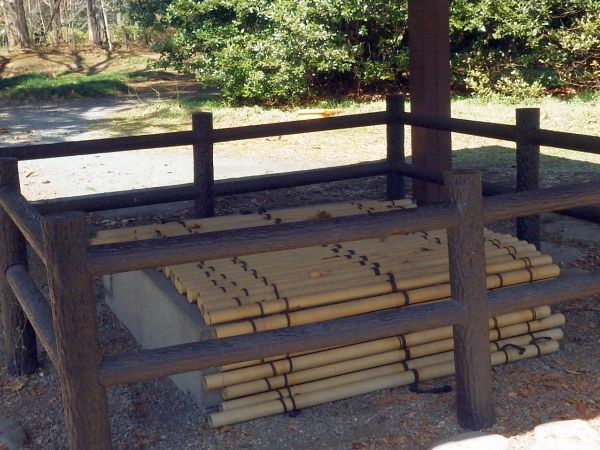(Upload on August 10 2024) [ 日本語 | English ]
Mount Usu / Sarobetsu post-mined peatland
From left: Crater basin in 1986 and 2006. Cottongrass / Daylily
HOME > Lecture catalog / Research summary > Glossary > Education > Out-size
[ arboretum ]
Organized efforts to educate about how natural environments function and how humans manage their behavior and ecosystems fpr the sustainability of human societies.
Focus
Debate (ディベート)A process involving formal discussion on a particular topic
debater (affirmative and negative sides) |
Active learning (Al)Rubric (ルーブリック)an evaluation tool or set of guidelines used to promote the consistent application of learning expectations, learning objectives, or learning standards in the classroom, or to measure their attainment against a consistent set of criteriaSTS= study of technology and society |
[GeoPark (ジオパーク), field trip (野外実習)]
Nature walk or field trip (≈ 自然観察会)A nature observation event or guided nature walk where participants explore natural environments to observe and learn about plants, animals, ecosystems, and seasonal changes. These events are often led by naturalists, scientists or educators and may include hands-on activities, species identification and ecological storytelling |
Depending on the context and audience of "自然観察会", we need to translate it as:
Nature walk: casual, general-purpose |
|
= botanic garden a garden dedicated to the collection, cultivation, research and display of a wide range of plants labelled with their botanical names → often establshed with herbarium Basic functions
Koishikawa Botanical Garden (小石川植物園)Experimental cultivation of sweet potatoesKonyo Aoki conducted experimental cultivation of sweet potatos in 1735, the first trial of its kind in the Tokyo area. His success initiated sweet potato cultivation throughout Japan as an emergency crop and is commemorated by a stone monument resembling a sweet potato.
Well of "Koishikawa Yojyosho"The Koishikawa Yojyosho (Charitable Hospital) was opened to the poor by the Tokugawa Shogunate on 10 January 1723 at this place and had accommodation for 40 (later 170) patients. This well was installed as a part of the Yojyosho. The plentiful water springing from this well was of high quality and therefore played a valuable role in saving refugees of the Tokyo Earthquake of 1923.Botanic Garden, Hokkaido University北海道大学北方生物圏フィールド科学センター植物園When the garden was opened in the late 19t century, it was surrounded by fertile soil with many springs called mem in Ainu and the land was covered by broad-leaved forests with Japanese elm, ash and alder. These springs and vegetation commonly seen in wetlands were found in this area because this garden is located on the edge of the alluvial fan built by the Toyohira River ("the mother river of Sapporo"). |
The Botanic Garden are making efforts to conserve the forest landscape and vegetation. The Hokkaido University Botanic Garden is a research oriented botanic garden in the northern part of Japan. Because this garden is located in cold climate, cool-climate plants can be grown in the open air, whereas in Honshu and areas further south, these plants are grown only in botanic gardens in highlands or climate-controlled low-temperature greenhouses. With this advantage, we collect, cultivate and exhibit boreal and alpine plants which are mostly from Hokkaido but also from other boreal and mountain areas. We also propagate and ex-situ conserve endangered plants. The Museum and Northern Peoples MuseumThe Museum, built by the Kaitaku-shi (Hokkaido Development Commission) in 1982 is the oldest building build for a museum in Hokkaido. Along with the surrounding buildings, it has been designated as an Important Cultural Property of Japan. This museum displays natural history and historical collections by the Kaitaku-shi and Hokkaido University. The Northern Peoples Museum displays artifacts related to cultural materials and livelihood of the aboriginal peoples of Hokkaido, the Ainu.Arboretum (pl. arboreta) (樹木園)One of the botanical gardens containing living collections of woody plantsParticular, for
fruticetum (灌木園): shrubs |
An activity of providing services to any populations who might not otherwise have access to those services
Lifelong learning (生涯教育)≈ career-long education, lifelong education, lifetime education and permanent education1965 Lengrand, Paul (UNESCO): proposed life-long integrated education a form of self-initiated education that is focused on personal development (no standardized definition) Recurrent education (リカレント教育)Rehn, Gösta (economist, Sweden, 1913-11996) |
1951 Rehn–Meidner model 1962 head, the Department of Labour and Social Affairs, OECD (Paris) 1973 For greater flexibility in working life. OECD Observer 62 Legacy resource (継承資源)Def. tangible or intangible assets inherited from previous generations, considered valuable for education, identity or community continuityEx. Cultural or educational contexts
Oral histories or traditional knowledge passed down in a community |
Hybrid learningOpportunities for creative, flexible course design (Dimitrov 2021, FD)Identify key characteristics of hybrid course design Describe examples of pre-and in-class learning activities that can be used to engage students in the hybrid class room Reflect on which components of a lesson are best suited to synchronous versus asynchronous modalities Work in small groups to discuss how a course concept you currently instruct could be redesigned using a hybrid model Hybrid/blended Learning InvolvesThe thoughtful integration of the face-to-face and online modalities, where activities and assessments are designed for meaningful student learning, taking into account the overall coherence of the learning experience. (Picciano 2006, Vaughan et al. 2013)
F2F |
Definitions of hybrid/blended learningnot strict but ...Case York U: F2F instruction is replaced by online instruction for 1/3 of the course, while 1/3 is delivered F2F. The remaining third may be any combination of online or F2F. Total course contact hours will remain the same as a traditional F2F course. Benefits
|